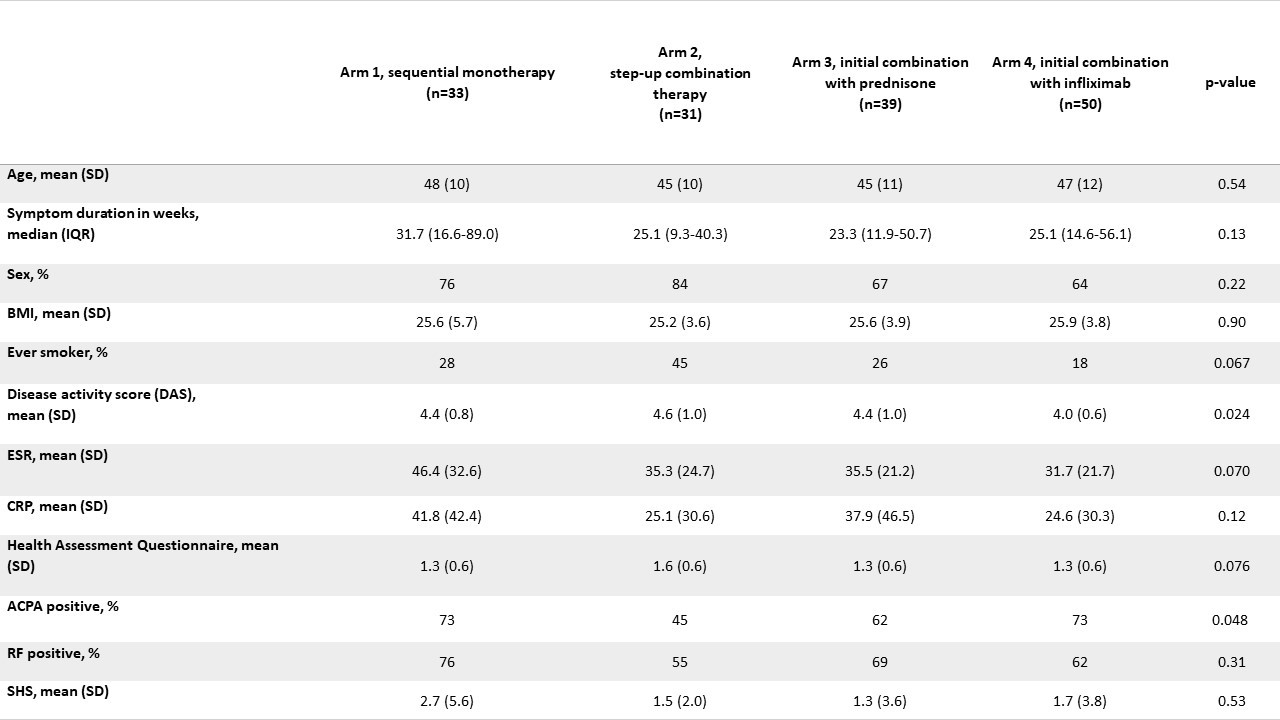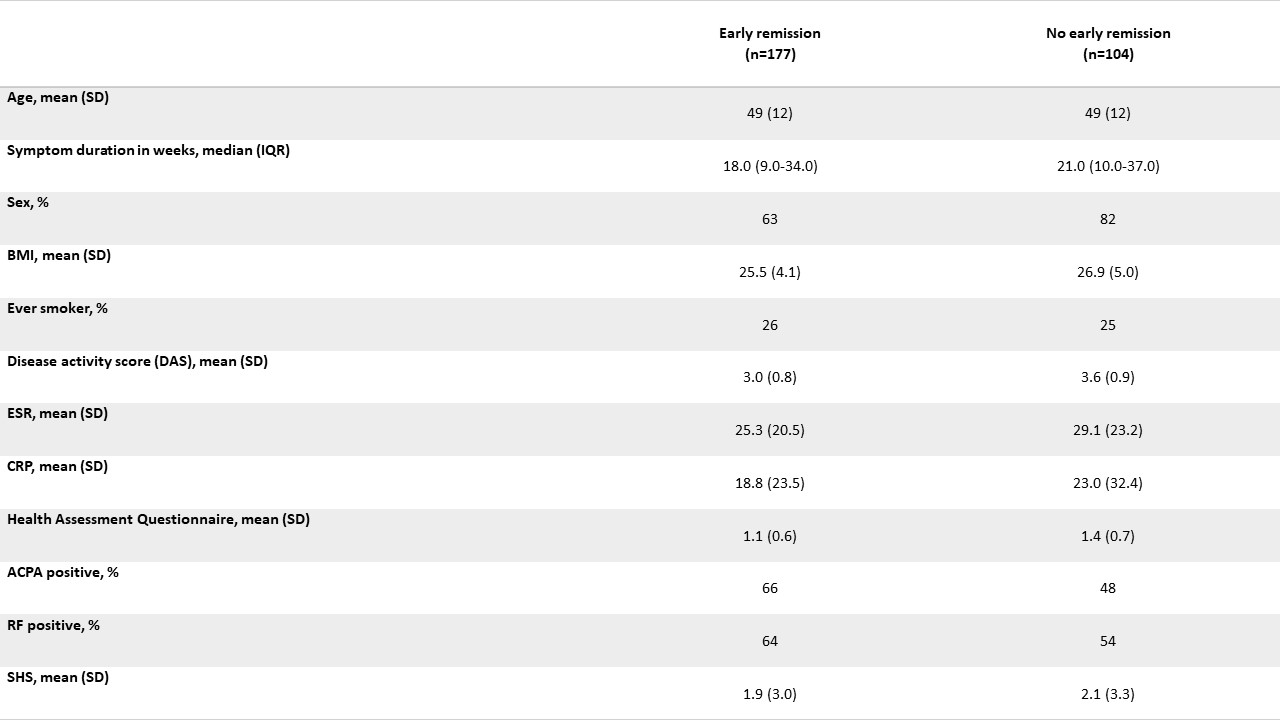Session Information
Date: Monday, November 13, 2023
Title: (1264–1307) RA – Diagnosis, Manifestations, and Outcomes Poster II
Session Type: Poster Session B
Session Time: 9:00AM-11:00AM
Background/Purpose: In 2 trials with an original follow-up of 5-10 years, patients with early arthritis were treated to target, resulting in low disease activity or remission in the majority of patients and limited radiographic progression. We invited former participants for a long-term follow-up (‘RECALL’) visit.
Methods: In BeSt (inclusion 2000-2002) 508 patients with early RA were randomized to: 1. Sequential DMARD monotherapy; 2. Step-up combination therapy; 3. Initial csDMARD combination therapy with prednisone or 4. Initial combination of MTX + infliximab, and treated-to-target DAS≤2.4 for 10 years. In IMPROVED (inclusion 2007-2010) 610 patients with early RA or UA received induction therapy with MTX + prednisone, with DAS< 1.6 as a treatment target. After 4 months 67% were in DAS remission (early remission). From 2019 to 2022 patients from both trials were invited for follow-up (after 20/12 years respectively). Outcomes were functional ability (HAQ), disease activity (3-component DAS) and radiographic damage (Sharp/Van der Heijde score, SHS, based on hands/feet X-rays of BeSt/IMPROVED at baseline & RECALL study visit, assessed by one reader (intrareader coefficient 0.98)). All outcomes had < 6% missing. In BeSt, SHS was compared between treatment arms with a generalized linear model, adjusted for unequally distributed patient characteristics across treatment arms (baseline DAS, ACPA; table 1). In IMPROVED, SHS was compared between patients that had been in early remission vs. not in early remission, adjusted for possible confounders (baseline DAS, ACPA, BMI).
Results: 45% (153/339) of alive BeSt patients participated (table 1). Their mean age at BeSt baseline was 46±11 years (non-participants/deceased: baseline age 58±13 years). At 20-year follow-up, median HAQ was 0.75, IQR 0.25-1.25; 0.54±0.7 lower than at baseline. Mean DAS was 1.5±0.6, with 137/151 (91%) of patients with DAS≤2.4 and 102/151 (68%) in DAS remission. Overall median SHS at RECALL visit was 13 (IQR 6-36) with a median progression of SHS 11 (IQR 5-30) since baseline. Compared to the other arms, SHS was lower in arm 4 (median SHS (IQR) 17 (8-58) in arm 1, 14 (3-28) in arm 2, 22 (7-42) in arm 3 and 9 (3-27) in arm 4). After adjusting for baseline differences this difference was statistically significant for arms 1 (p=0.02) and 3 (p=0.01), but not for arm 2 (p=0.16). 54% (282/523) of alive IMPROVED patients participated (table 2). Their mean age at IMPROVED baseline was 49±12 years (non-participants/deceased: 55±15 years). At 12-year follow-up, median HAQ was 0.50, IQR 0-1.0; 0.56±0.7 lower than at baseline. Mean DAS was 1.4±0.7, with 255/279 (91%) of patients with DAS≤2.4 and 189/279 (68%) in DAS remission. Overall median SHS was 8 (IQR 3-16) with a median SHS progression since baseline of 6 (IQR 3-13). Median SHS (IQR) was 10 (IQR 4-17) in the early remission group vs 6 (IQR 2-15) in patients that had not been in early remission. There was no statistically significant difference after adjusting for possible confounders (p=0.28).
Conclusion: 91% of patients who attended long term follow-up of BeSt/IMPROVED after respectively 20 and 12 years were in remission or low disease activity, with a median HAQ of 0.75/0.50 and clinically significant SHS progression of median 11/6 points.
To cite this abstract in AMA style:
Heckert S, Maassen J, Nevins I, Fodili F, Steup-Beekman M, Huizinga T, Bergstra S, Allaart C. Long-term Follow-up of Treated-to-target RA and UA: Results of the BeSt and IMPROVED Studies [abstract]. Arthritis Rheumatol. 2023; 75 (suppl 9). https://acrabstracts.org/abstract/long-term-follow-up-of-treated-to-target-ra-and-ua-results-of-the-best-and-improved-studies/. Accessed .« Back to ACR Convergence 2023
ACR Meeting Abstracts - https://acrabstracts.org/abstract/long-term-follow-up-of-treated-to-target-ra-and-ua-results-of-the-best-and-improved-studies/


